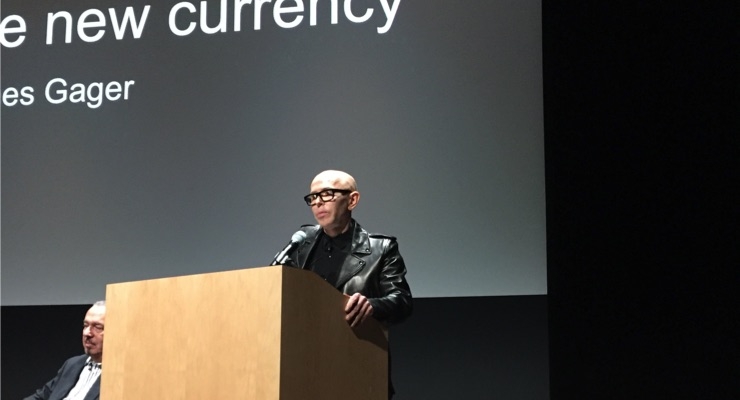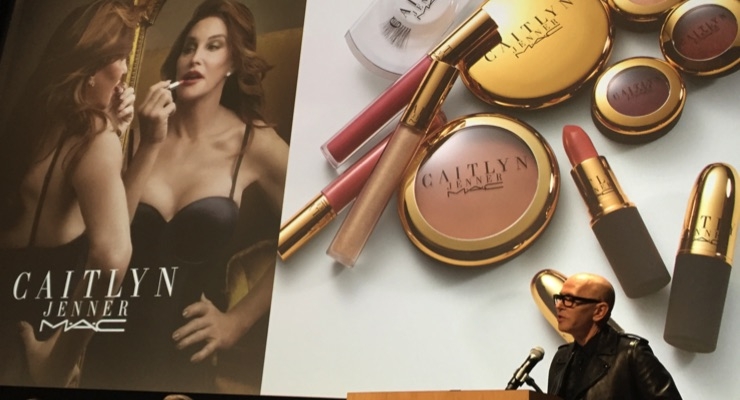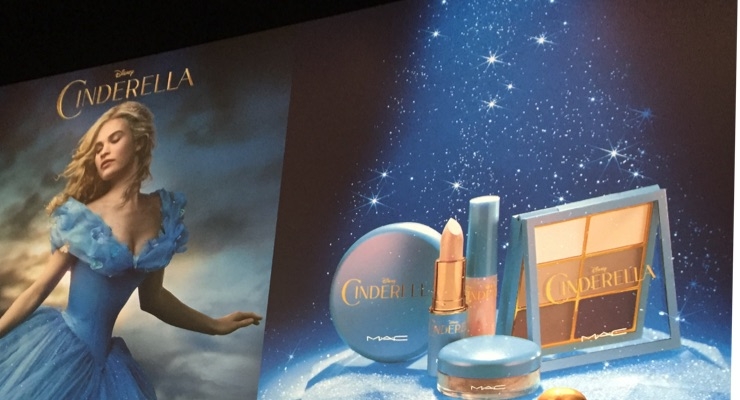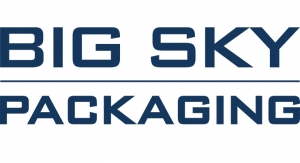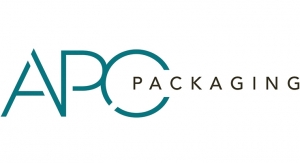Jamie Matusow, Editor-in-Chief11.17.16
Pratt Institute’s first annual symposium “Design Is the New Currency” was held on November 2 at The Whitney Museum of American Art in Manhattan. More than 200 designers, professionals and aficionados from diverse worlds of architecture, art, beauty and packaging, gathered in the museum’s auditorium to hear world-renowned designers speak about how design is influencing and changing our daily lives.
Fascinating presentations were given by David Rockwell, Juan Montoya, Michele Oka Doner and—representing the cosmetics world—James Gager, SVP and creative director for MAC and global creative director for Jo Malone and La Mer.
The symposium was conceived and moderated by fragrance and cosmetics packaging designer and Pratt professor Marc Rosen, and sponsored by The Marc Rosen Educational Fund at Pratt Institute in conjunction with Juliana Curran Terain, the Terain Foundation.
The panelists delved into a passionate discussion of how in an ever-changing world, Design has become the x-plus factor. Key takeaways follow. Consumers know that they are buying Design and embrace their need to identify with products that support their sense of taste, sophistication and worth. In a world that has blurred class distinctions and fueled the consumer’s need to underscore their own identity with a personal style that defines them, Design has become an important part of their DNA. If ‘Design is the New Currency’ then a designer’s imagination is the bank from which to draw new ideas.
Looking at Design as an experience now sought out by consumers, here are some thoughts voiced by each of the panelists:
Marc Rosen noted, “The packaging gives us a sense of sophistication and self-esteem. The price is worth it. In my world of fragrance and cosmetics, we have known for years that 'the package is.... The silent salesman.’”
David Rockwell, who discussed a number of his projects, including commissions for Knoll furniture, restaurants, stage sets, the TED theater, Imagination Playgrounds and airline terminals, felt strongly that “Offices do not need to look like prison cells. The community-space office is where people can be reminded of traditions and customs.” He commented that he likes “the specificity of design.”
Artist/sculptor/innovator, Michele Oka Doner—who incorporates stunning elements of the natural world into her work on everything from large scale to intimate objects—answered the question “What is design’s new currency?” by saying: “It's a license to create with your own philosophy..." She noted that “Design has been with us since the Egyptians, who exhibited the first aesthetics, the first ‘cosmetic palettes.’” She added: “They thought about the rituals, the ceremony, of everyday life.” Doner told the audience that she thinks design is still in its infancy. “It gives us an anchor,” she said, “and should give us a moment of contemplation every day.”
Interior designer extraordinaire Juan Montoya shared photos of a number of properties he had composed, elaborating on some of his techniques that make a space unique. He told the crowd: “We see design as a translation, as a ‘package.’ The ‘package’ is completed when the traditional is mixed with the modern.” The ‘package,’ he said “is how you see the space from the exterior.”
James Gager, began his presentation by describing his personal commitment: “Design is an integral part of MAC—and my own life.” MAC is recognized for its emotional connection and for storytelling, which Gager said is such a major ingredient when it comes to makeup design. With consumers taking in so much information every day via videos and social media, he said that design has had to change: “It’s now about creating a different language.” He spoke about how there’s now a visual language as well as a written language, providing examples such as the influx of emoticons into “vocabulary,” and adding that the brain processes pictures 6,000 times faster than text. Gager addressed the rising tide of consumers’ desire for personalization, saying, “When individuals can customize designs, the design becomes the currency for personal branding and self-expression.”
MAC designs and launches about 60 collections a year.
James Gager Meetup
Following the thoughtful and engaging symposium, Beauty Packaging had the chance to catch up with Gager to get a few of his thoughts on cosmetics packaging.
Beauty Packaging: What trends do you see ahead for cosmetics packaging?
James Gager: The trends I see for cosmetic packaging should be directly related to the DNA of your brand. With that said, it’s hard to be specific except to say I think new materials and technology and being kind to our universe are guiding factors…personally I like the idea of transparent cartons…all exposed.
Beauty Packaging: What is the No.1 thing to keep in mind as far as “packaging an experience” in cosmetics?
James Gager: Number one thing to keep in mind as “packaging as experience” is that the package needs to function. Love the Bauhaus philosophy of “form follows function;” utilizing this as a guiding principle could lead to newer, less contrived forms. I see a lot of repetitive ideas happening in the marketplace today.
Beauty Packaging: What design attribute do you think resonates most with the consumer when choosing cosmetics?
James Gager: Don’t have an answer [to this]. It totally depends on the consumer, what they might be looking for or what they’re not looking for and are seduced by. Sometimes it’s the actual cosmetic product that resonates, sometimes it’s the brand, sometimes it’s the package and its uniqueness, deco, etc.
Beauty Packaging: Was there anything in particular that inspired you as you listened to the other designers on the panel this evening?
James Gager: I was inspired by the depth and quality of work done by the other designers on the panel…superb! Also loved Michelle’s storytelling of her journey and inspiration. I like to hear what inspires people…what makes them unique and how they see the world through their work and eyes.
Through examples and discussion, Pratt’s first symposium—which highlighted different fields of study in the curriculum—proved to be a truly inspiring event for all who attended.
Read More
What Is Luxury? James Gager Explains How MAC Cosmetics Defines It
Fascinating presentations were given by David Rockwell, Juan Montoya, Michele Oka Doner and—representing the cosmetics world—James Gager, SVP and creative director for MAC and global creative director for Jo Malone and La Mer.
The symposium was conceived and moderated by fragrance and cosmetics packaging designer and Pratt professor Marc Rosen, and sponsored by The Marc Rosen Educational Fund at Pratt Institute in conjunction with Juliana Curran Terain, the Terain Foundation.
The panelists delved into a passionate discussion of how in an ever-changing world, Design has become the x-plus factor. Key takeaways follow. Consumers know that they are buying Design and embrace their need to identify with products that support their sense of taste, sophistication and worth. In a world that has blurred class distinctions and fueled the consumer’s need to underscore their own identity with a personal style that defines them, Design has become an important part of their DNA. If ‘Design is the New Currency’ then a designer’s imagination is the bank from which to draw new ideas.
Looking at Design as an experience now sought out by consumers, here are some thoughts voiced by each of the panelists:
Marc Rosen noted, “The packaging gives us a sense of sophistication and self-esteem. The price is worth it. In my world of fragrance and cosmetics, we have known for years that 'the package is.... The silent salesman.’”
David Rockwell, who discussed a number of his projects, including commissions for Knoll furniture, restaurants, stage sets, the TED theater, Imagination Playgrounds and airline terminals, felt strongly that “Offices do not need to look like prison cells. The community-space office is where people can be reminded of traditions and customs.” He commented that he likes “the specificity of design.”
Artist/sculptor/innovator, Michele Oka Doner—who incorporates stunning elements of the natural world into her work on everything from large scale to intimate objects—answered the question “What is design’s new currency?” by saying: “It's a license to create with your own philosophy..." She noted that “Design has been with us since the Egyptians, who exhibited the first aesthetics, the first ‘cosmetic palettes.’” She added: “They thought about the rituals, the ceremony, of everyday life.” Doner told the audience that she thinks design is still in its infancy. “It gives us an anchor,” she said, “and should give us a moment of contemplation every day.”
Interior designer extraordinaire Juan Montoya shared photos of a number of properties he had composed, elaborating on some of his techniques that make a space unique. He told the crowd: “We see design as a translation, as a ‘package.’ The ‘package’ is completed when the traditional is mixed with the modern.” The ‘package,’ he said “is how you see the space from the exterior.”
James Gager, began his presentation by describing his personal commitment: “Design is an integral part of MAC—and my own life.” MAC is recognized for its emotional connection and for storytelling, which Gager said is such a major ingredient when it comes to makeup design. With consumers taking in so much information every day via videos and social media, he said that design has had to change: “It’s now about creating a different language.” He spoke about how there’s now a visual language as well as a written language, providing examples such as the influx of emoticons into “vocabulary,” and adding that the brain processes pictures 6,000 times faster than text. Gager addressed the rising tide of consumers’ desire for personalization, saying, “When individuals can customize designs, the design becomes the currency for personal branding and self-expression.”
MAC designs and launches about 60 collections a year.
James Gager Meetup
Following the thoughtful and engaging symposium, Beauty Packaging had the chance to catch up with Gager to get a few of his thoughts on cosmetics packaging.
Beauty Packaging: What trends do you see ahead for cosmetics packaging?
James Gager: The trends I see for cosmetic packaging should be directly related to the DNA of your brand. With that said, it’s hard to be specific except to say I think new materials and technology and being kind to our universe are guiding factors…personally I like the idea of transparent cartons…all exposed.
Beauty Packaging: What is the No.1 thing to keep in mind as far as “packaging an experience” in cosmetics?
James Gager: Number one thing to keep in mind as “packaging as experience” is that the package needs to function. Love the Bauhaus philosophy of “form follows function;” utilizing this as a guiding principle could lead to newer, less contrived forms. I see a lot of repetitive ideas happening in the marketplace today.
Beauty Packaging: What design attribute do you think resonates most with the consumer when choosing cosmetics?
James Gager: Don’t have an answer [to this]. It totally depends on the consumer, what they might be looking for or what they’re not looking for and are seduced by. Sometimes it’s the actual cosmetic product that resonates, sometimes it’s the brand, sometimes it’s the package and its uniqueness, deco, etc.
Beauty Packaging: Was there anything in particular that inspired you as you listened to the other designers on the panel this evening?
James Gager: I was inspired by the depth and quality of work done by the other designers on the panel…superb! Also loved Michelle’s storytelling of her journey and inspiration. I like to hear what inspires people…what makes them unique and how they see the world through their work and eyes.
Through examples and discussion, Pratt’s first symposium—which highlighted different fields of study in the curriculum—proved to be a truly inspiring event for all who attended.
Read More
What Is Luxury? James Gager Explains How MAC Cosmetics Defines It

